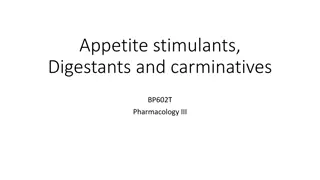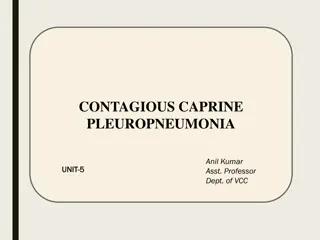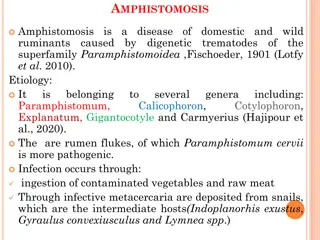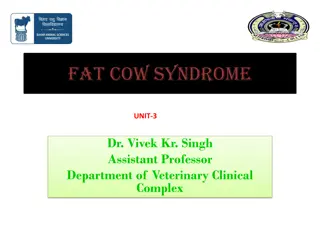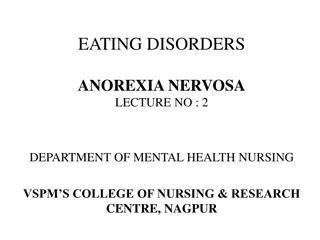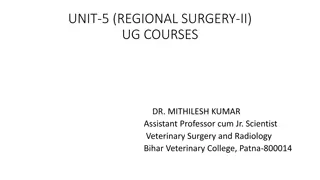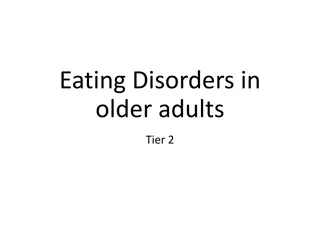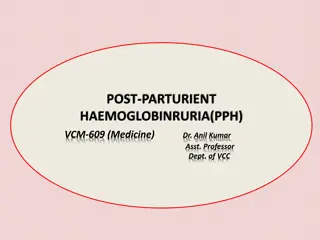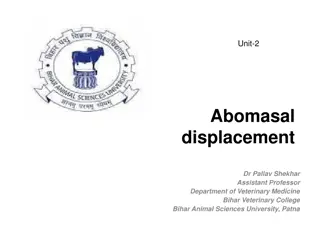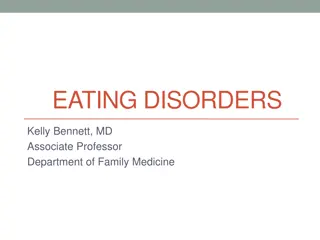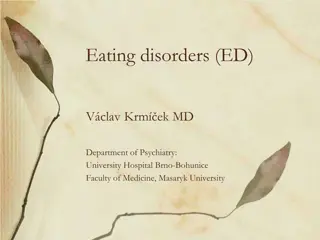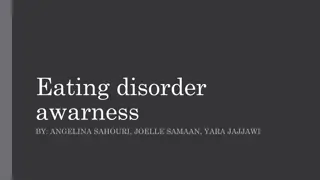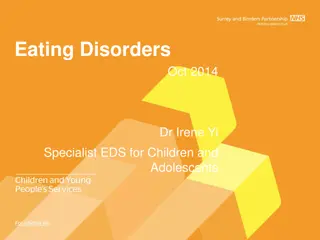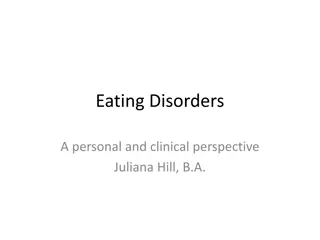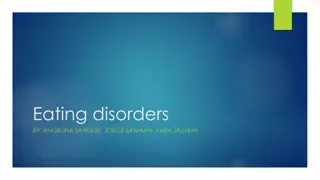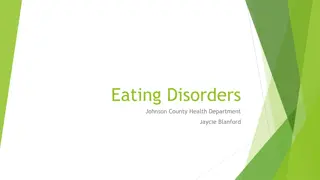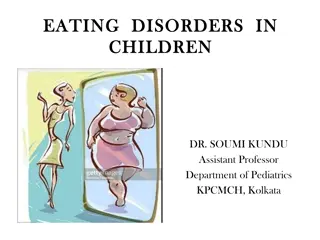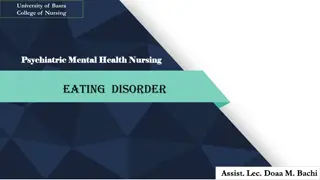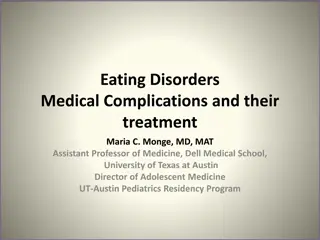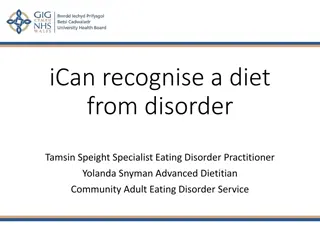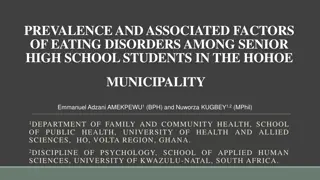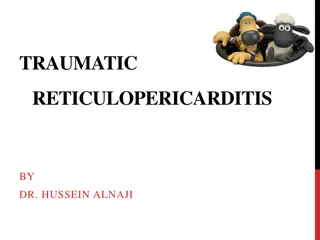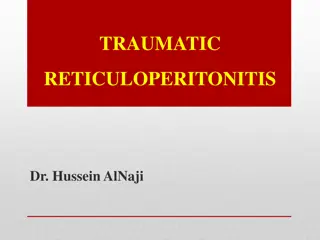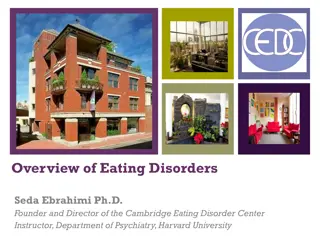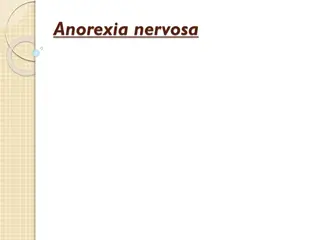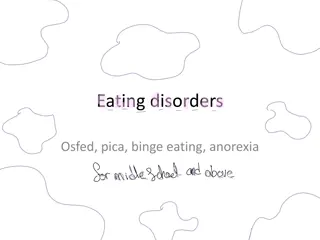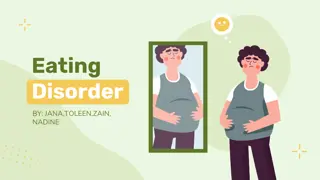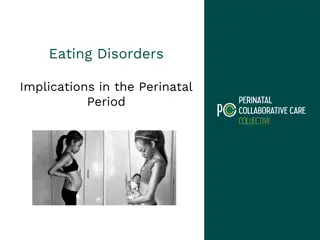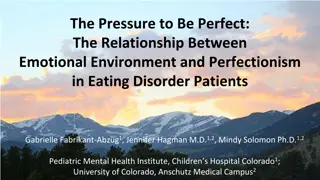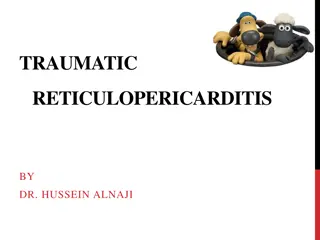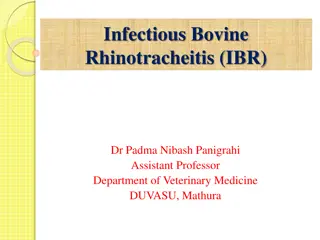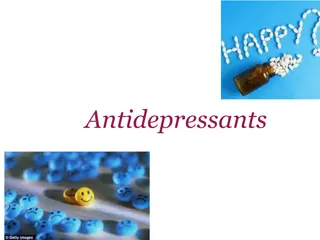Appetite Stimulants, Digestants, and Carminatives in Pharmacology III
Appetite is influenced by various factors including hypothalamic peptides, catecholaminergic pathways, and serotoninergic signaling. Loss of appetite, like anorexia, can stem from both physical and psychological causes. Alcohol can stimulate gastric secretion but chronic consumption may reduce appet
0 views • 8 slides
Contagious Caprine Pleuropneumonia in Goats
Contagious Caprine Pleuropneumonia is a severe and frequently fatal respiratory disease affecting goats in India. Caused by Mycoplasma capricolum subsp. Capripneumoniae, it is not transmissible to cattle or sheep. The disease spreads through close contact and inhalation of respiratory droplets, with
0 views • 6 slides
Amphistomosis in Ruminants: Causes, Symptoms, and Diagnosis
Amphistomosis is a disease in ruminants caused by several types of rumen flukes. It leads to productivity losses, weight loss, fertility reduction, and other symptoms. Infection occurs through ingestion of contaminated vegetables and raw meat. The parasite affects the rumen and reticulum of sheep, g
0 views • 8 slides
Fat Cow Syndrome in Cattle: Causes, Symptoms, and Treatment
Fat Cow Syndrome, also known as Fatty Liver Disease in Cattle, is a condition commonly seen in high-producing cows during the transition period around calving. The disease is characterized by mobilization of excessive body fat to the liver due to negative energy balance, leading to hepatic lipidosis
1 views • 10 slides
Anorexia Nervosa: Causes, Symptoms, and Treatment
Eating disorders, particularly anorexia nervosa, are serious psychological illnesses characterized by abnormal eating habits leading to detrimental effects on physical and mental health. This lecture discusses the definition, etiology, clinical features, and treatment options for anorexia nervosa, h
3 views • 29 slides
Abomasal Displacement in Veterinary Medicine
Abomasal displacement refers to the movement of the abomasum, a wandering organ in cattle due to loose attachments. This condition can lead to left or right displacement, as well as torsion or volvulus. Various factors such as feeding high concentrate rations, metabolic alkalosis, and other metaboli
0 views • 27 slides
Eating Disorders in Older Adults
Eating disorders can affect older adults too, yet they are often overlooked or misdiagnosed. Challenges in diagnosing these disorders arise from various underlying health conditions. Types of eating disorders include anorexia nervosa, bulimia nervosa, binge eating disorder, and others. Recognizing c
0 views • 7 slides
Post-Parturient Haemoglobinuria in Dairy Cows
Post-Parturient Haemoglobinuria (PPH) is a metabolic disease affecting high-producing dairy cows after calving, characterized by hemolysis, hemoglobinuria, and anemia. Common in buffaloes and cows, it is caused by phosphorus deficiency in diet, affecting intracellular functions and leading to clinic
0 views • 9 slides
Abomasal Displacement in Dairy Cattle
Abomasal displacement is a common issue in older lactating dairy cattle, often related to inadequate nutrition and concurrent diseases. This condition involves the displacement of the abomasum from its normal position, causing symptoms like anorexia, ketosis, and dehydration. Learn about the causes,
1 views • 21 slides
Eating Disorders: Diagnostic Criteria, Signs, and Treatments
This presentation covers the diagnostic criteria, signs, and treatments for anorexia nervosa, bulimia nervosa, and binge-eating disorder. It details the subtypes, severity levels, prevalence, development, courses, and risk factors associated with eating disorders, providing a comprehensive overview
1 views • 32 slides
Anorexia Nervosa: Symptoms and Psychopathology
Anorexia nervosa is a serious eating disorder characterized by food restriction, bingeing, purging, and distorted body image. Common symptoms include excessive exercise, body checking, and rigid food rules. Psychopathology aspects include intrusive dread of fatness, self-imposed low weight threshold
0 views • 42 slides
Healthy Living Tips and Information on Eating Disorders
Various images and descriptions cover a range of topics including healthy food choices, the importance of carbohydrates, engaging in sports activities like swimming and football, and the risks and characteristics of eating disorders such as anorexia and bulimia. Links to relevant YouTube videos are
0 views • 7 slides
Eating Disorders: Types, Signs, Effects, and Recovery
Eating disorders are mental disorders characterized by unhealthy eating habits and can have severe physical and psychological consequences. This article explores the definition of eating disorders, signs to look out for, different types such as Anorexia Nervosa, Bulimia Nervosa, Pica, and Purging Di
1 views • 10 slides
Eating Disorders in Children and Adolescents: Insights from Dr. Irene Yi
This comprehensive presentation by Dr. Irene Yi delves into eating disorders, including Anorexia Nervosa and Bulimia, in children and adolescents. The content covers types of eating disorders, developmental perspectives, assessment stages, and management strategies. NICE guidelines for managing eati
0 views • 25 slides
Eating Disorders: A Personal and Clinical Perspective
This insightful content delves into eating disorders from a personal narrative and clinical standpoint, covering Anorexia Nervosa, Bulimia Nervosa, and Eating Disorder Not Otherwise Specified (EDNOS). It provides criteria for each disorder, facts, and statistics, shedding light on the challenges, im
1 views • 15 slides
Eating Disorders: Types, Signs, and Recovery
Eating disorders are mental disorders characterized by unusual eating habits that can negatively impact physical and mental health. They manifest in various forms such as anorexia nervosa, bulimia nervosa, pica, and purging disorder. Recognizing signs like changes in weight, body image obsession, an
0 views • 6 slides
Eating Disorders: Insights and Treatments
Body dissatisfaction is prevalent in both men and women, leading to the development of eating disorders like anorexia nervosa and bulimia nervosa. Anorexia nervosa is characterized by restricted food intake and intense fear of weight gain, while bulimia nervosa involves binge eating and purging beha
0 views • 13 slides
Eating Disorders in Children by Dr. Soumi Kundu
Eating disorders in children, such as anorexia nervosa, bulimia nervosa, and binge eating disorder, are complex biopsychosocial disorders characterized by dysfunctional patterns of cognition and weight control behaviors. They result in significant physical, psychological, and social complications. T
0 views • 34 slides
Eating Disorders: An Overview from University of Basra College of Nursing
Eating disorders have a long history, with anorexia nervosa established as a mental disorder in the 1960s and bulimia nervosa described later. These disorders can be viewed on a continuum, with anorexia, bulimia, and obesity at different ends. Anorexia nervosa is characterized by restrictive behavio
0 views • 30 slides
Eating Disorders: Medical Complications and Treatment
This presentation by Dr. Maria C. Monge covers the common eating disorders in teenage patients, potential medical complications, and the role of the medical team in treatment. It includes definitions of disorders like Anorexia Nervosa, Bulimia Nervosa, and Binge Eating Disorder according to DSM-5 cr
2 views • 60 slides
Eating Disorders: Types, Signs, and Support
Eating disorders encompass unhealthy attitudes towards food and body image, affecting individuals' physical and mental well-being. Types such as anorexia nervosa, bulimia, binge eating disorder, and OSFED are discussed, along with the emotional aspects of these conditions. Recognizing signs, seeking
0 views • 45 slides
Prevalence and Factors of Eating Disorders Among High School Students
Eating disorders pose serious risks to individuals, influenced by various factors such as genetics, trauma, and sociocultural ideals. The disorders, including anorexia nervosa and bulimia nervosa, have high mortality rates and often coexist with other mental conditions. Recognizing signs like body i
1 views • 28 slides
Traumatic Reticulopericarditis in Livestock: Causes, Symptoms, and Management
Traumatic reticulopericarditis in livestock is caused by penetration of the pericardial sac by a migrating metal foreign body, leading to pericarditis, toxemia, and congestive heart failure. Clinical signs include depression, anorexia, respiratory distress, and bilateral jugular distension. If chron
0 views • 13 slides
Traumatic Reticuloperitonitis in Cattle
Traumatic reticuloperitonitis in cattle is a severe condition caused by the penetration of the reticulum by metallic foreign objects. The ingestion of these objects leads to acute local peritonitis, with symptoms like anorexia, decreased milk yield, and pain during movement. If left untreated, it ca
0 views • 16 slides
Eating Disorders: Overview, Prevalence, and Types
This detailed information covers the prevalence of eating disorders in the U.S., including statistics on anorexia, bulimia, and binge eating disorder. It also delves into the impact of eating disorders on children and adolescents, highlighting disturbing trends in body image and obesity rates. Addit
2 views • 30 slides
Anorexia Nervosa, Bulimia Nervosa, and Post-Partum Psychiatric Disorders
Anorexia nervosa is characterized by significant weight loss, fear of gaining weight, and disturbed body image. It predominantly affects women in adolescence, often associated with dieting and harmful behaviors. Diagnosis involves criteria such as weight loss and amenorrhea. Complications include em
0 views • 14 slides
Eating Disorders: Types, Causes, and Treatment Options
Eating disorders such as OSFED, pica, binge eating, and anorexia are significant conditions that impact health, emotions, and daily functions. They are characterized by persistent detrimental eating patterns. Treatment for OSFED is individualized and can include evidence-based therapies. Binge eatin
0 views • 16 slides
Eating Disorders Treatment in the UK
Eating disorders encompass a range of conditions characterized by unhealthy eating habits and preoccupation with food, body weight, and shape. Common types include anorexia nervosa, bulimia nervosa, and binge eating disorder. These conditions often a
3 views • 6 slides
Eating Disorder
Eating disorders are psychological conditions affecting eating patterns and emotions. They include anorexia, bulimia, binge eating disorder, and more. While common in Jordan, many don't seek help due to lack of awareness. Prevention involves addressing unrealistic beauty standards and negative food
0 views • 6 slides
Exercise Therapy in Treating Eating Disorders
Exercise therapy plays a crucial role in treating eating disorders like anorexia and bulimia. Anorexia nervosa is characterized by severe calorie restriction, excessive exercise, and distorted self-perception, while bulimia nervosa involves binge-eating and purging behaviors. Understanding the impac
0 views • 23 slides
Eating Disorders
Eating disorders in the perinatal period can have serious implications on pregnancy and neonatal outcomes. Screening for disorders like Anorexia Nervosa, Bulimia Nervosa, and Binge Eating Disorder is crucial to prevent complications and ensure proper management. Understanding the effects of these di
0 views • 23 slides
Relationship Between Emotional Environment and Perfectionism in Eating Disorder Patients
Eating disorders are a growing concern, with family emotional environment playing a pivotal role in their development. This study delves into the impact of criticism and perfectionism on individuals with eating disorders, shedding light on the correlation between emotional environment within familie
0 views • 15 slides
TRAUMATIC RETICULOPERICARDITIS
Traumatic reticulopericarditis is a serious condition in animals caused by a sharp foreign body penetrating the pericardial sac, leading to pericarditis, toxemia, and congestive heart failure. Clinical signs include depression, anorexia, recumbency, rapid weight loss, and more. Prompt diagnosis and
0 views • 13 slides
Infectious Bovine Rhinotracheitis (IBR)
Infectious Bovine Rhinotracheitis (IBR) is a viral disease affecting cattle, buffaloes, and wild ruminants, caused by Bovine herpesvirus. It has various forms, including respiratory, genital, and encephalitic, with different methods of transmission. Clinical signs include rhinitis, tracheitis, conju
0 views • 25 slides
Media's Impact on Feminine Body Image and Identity
Foucault's analysis explores how media shapes societal views on the feminine body, from traditional ideals to emerging discourses like AlphaGirl and Future Girl. This influence can lead to unrealistic body standards and harmful behaviors, such as anorexia and bulimia. The depiction of feminine bodie
0 views • 13 slides
Antidepressants
Antidepressants are medications used to treat depression and other mental health conditions. They work by affecting neurotransmitters in the brain, specifically serotonin and norepinephrine. The monoamine hypothesis of depression suggests that a deficiency in these neurotransmitters is linked to dep
1 views • 33 slides
